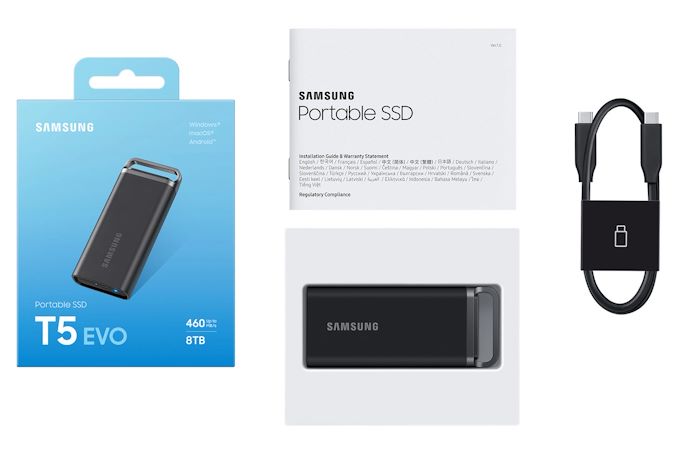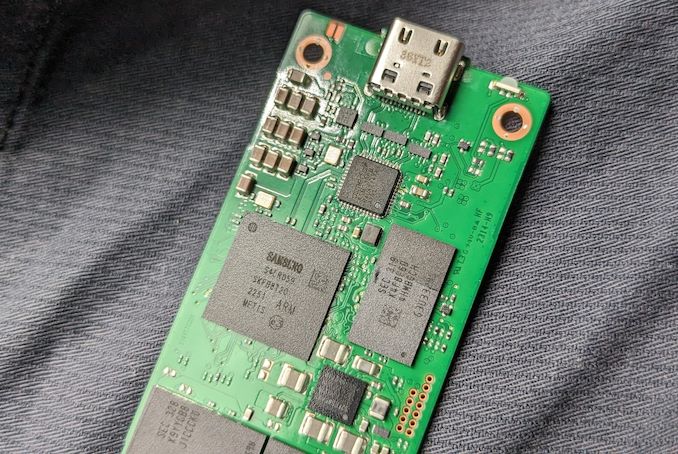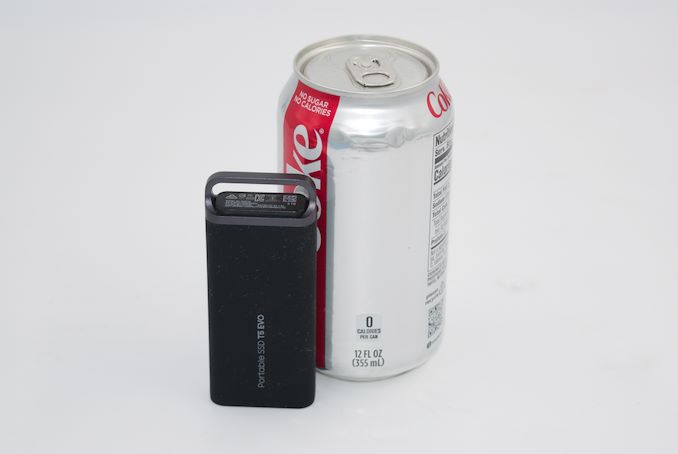
Original Link: https://www.anandtech.com/show/21135/samsung-t5-evo-portable-ssd-review-qlc
Samsung T5 EVO Portable SSD Review: QLC Sets Sane Expectations, Insane Pricing
by Ganesh T S on November 14, 2023 10:00 AM EST- Posted in
- Storage
- SSDs
- Samsung
- USB 3.0
- flash
- DAS
- Type-C
- External SSDs
- Portable SSDs
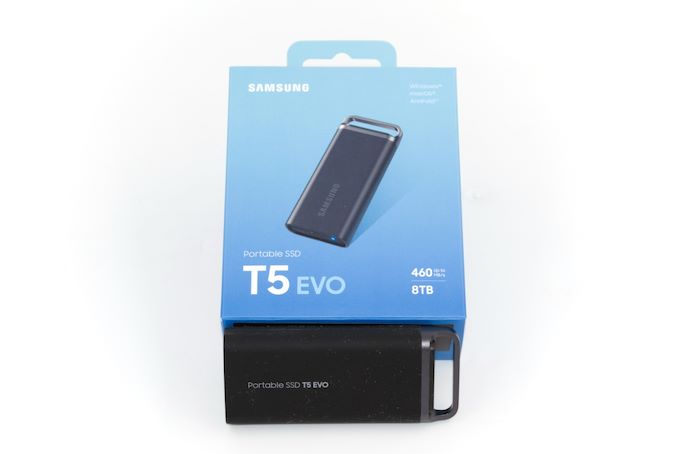
The market for portable SSDs has shown rapid growth over the past decade or so. Almost all tier-one flash vendors (including Samsung, Western Digital / SanDisk, Micron / Crucial, and SK hynix) have their own PSSD lineup. Other than SK hynix, the others in the list have multiple PSSD models in the market. This has allowed them to target different market segments in terms of performance / serviced use-cases and cost. Samsung was one of the first tier-one vendors to pay attention to this market with the launch of the T1 Portable SSD in 2015. Since then, the company has been regularly introducing new PSSD models in the T series, while also launching the Thunderbolt-compliant X5.
The T5 EVO Portable SSD being launched today by Samsung heralds a new category in the PSSD space - high-capacity flash storage limited to entry level speeds. The minimum capacity point in the T5 EVO PSSD family is 2 TB, with options for the consumer to scale up to 4 TB and 8 TB based on user requirements. Pricing is kept reasonable by the use of QLC flash. Samsung is no strager to using QLC flash in high-capacity consumer storage products. The 860 QVO and 870 QVO SATA SSDs were launched in 2018 and 2020 with a 8 TB version at the high end in the latter. Samsung's use of dynamic SLC caching ('Intelligent TurboWrite' in their marketing parlance (PDF)) allowed these drives to offer compelling $/TB metrics while delivering enough performance for day-to-day PC usage. However, the performance after running out of the SLC cache was abysmal and even worse than 2.5" hard drives.
The T5 EVO PSSD is not the first in the market to use QLC flash. Sabrent had used QLC flash in their lineup of dual-mode (Thunderbolt + USB) drives marketed under the XTRM Q tag. While the 4 TB and 8 TB capacity options for the XTRM Q were extremely attractive, and pricing was not outright ridiculous, the performance of the drives did not keep up with user expectations (particularly from the viewpoint of a Thunderbolt drive). Samsung is wisely avoiding this mis-step by limiting the T5 EVO to 5 Gbps speeds with its USB 3.2 Gen 1 Type-C connector. Can limiting the interface speeds for a QLC PSSD deliver better user experience? Samsung sent across the 8 TB variant of the T5 EVO to put through our rigorous direct-attached storage evaluation process. The review below investigates the performance profile of the PSSD sample and provides some comments on its value proposition.
Introduction and Product Impressions
The market for bus-powered direct-attached storage devices has expanded considerably over the last few years. Rapid advancements in 3D NAND technology, coupled with increasing confidence of manufacturers in QLC (4-bits per cell) has driven down the $/TB metric for capacious SSDs. On the host interface front, updates to the maximum speed have been clocking in at regular intervals. While USB 2.0 with its 480 Mbps speed held sway for more than 8 years, successive updates to 5 Gbps, 10 Gbps, 20 Gbps, 40 Gbps, and 80 Gbps have been introduced with a gap of 3 to 4 years between them. From the perspective of bus-powered storage devices, distinctive categories have emerged depending on the performance profile and internal components.
- 3GBps+ class: USB4 SSDs
- 2.5GBps+ class: Thunderbolt SSDs with PCIe 3.0 x4 NVMe drives
- 2GBps+ class: USB 3.2 Gen 2x2 SSDs with PCIe 3.0 x4 NVMe drives or native UFD controllers
- 1GBps+ class: USB 3.2 Gen 2 SSDs with PCIe 3.0 (x4 or x2) NVMe drives or native UFD controllers
- 500MBps+ class: USB 3.2 Gen 2 SSDs with SATA drives or native UFD controllers
- 400MBps+ class: USB 3.2 Gen 1 SSDs with SATA drives or native UFD controllers
- Sub-400MBps+ class: USB 3.2 Gen 1 flash drives with direct flash-to-USB (native UFD) controllers
The recent spate of product introductions has been in the first four categories, with a push for native UFD controllers that offer power consumption and thermal performance advantages. Therefore, it came as a bit of a surprise when Samsung sent across the details of the T5 EVO Portable SSD in the 400MBps+ class. The company is pitching the capacity options as the key selling point.
The T5 EVO is a 102g 95mm x 40mm x 17mm USB 3.2 Gen 1 PSSD made of solid metal with a rubber sleeve. The casing includes a metal ring for a lanyard, making it easy to carry around without fear of misplacing the drive. The T5 EVO's dimensions make it appear to be a thick and oversized thumb drive (without the protruding connector), but the full metal construction lends it enough weight to give users a solid feel when handling it. The unit includes a blue LED power indicator near the upstream Type-C port. The rubber covering provides it extra durability against external shocks (Samsung claims drop testing from a height of 2m, but the 3-year warranty doesn't cover physical damage caused by mishandling). Samsung includes a single 46cm USB 3.2 Gen 1 Type-C to Type-C cable in the package.
Samsung's 8TB 870 QVO SATA SSD has been in the market for a few years. Given a similar capacity point, and performance numbers below that of the 870 QVO (due to host interface limitations), we suspected that the T5 EVO platform would share a lot in common with the 870 QVO. Our suspicions were not unfounded, as shown in the teardown gallery below.
The internals of the T5 EVO are kept hidden away by a number of screws under different plastic overlays. After figuring out their locations and unscrewing them, the rubber sleeve could be removed to reveal the solid metal casing. Removal of four easy-to-spot screws on the underside of the metal case allows the two layers of the casing to become unclasped. This reveals the single-board solution, whose components are protected by thermal pads that lie tight against the metal casing under normal circumstances.
Similar to the 870 QVO, the 8TB T5 EVO incorporates four flash packages (two on each side of the board, as shown in the gallery). However, the part numbers are different. While the 870 QVO used the K9XVGB8J1A, the T5 EVO uses the K9YYGB8J1C (visible at the bottom of the board photograph above). The 870 QVO used Samsung's 9XL 3D V-NAND in QLC mode, but the new flash part number belongs to a different generation (likely decoding to 136L decoding to 7th Gen. - 176L - 3D V-NAND in QLC mode). The SATA controller (S4LR069 Metis) remains the same as the 870 QVO as does the presence of 8GB of LPDDR4 RAM for flash translation layer usage. The obvious additional component is the bridge chip - the ASMedia ASM235CM which bridges a single downstream SATA III port with a USB 3.2 Gen 1 (5 Gbps) Type-C upstream port.
The Samsung T5 EVO PSSD also includes hardware encryption support. Users can equip the PSSD with a password set via the Samsung Magician software.
CrystalDiskInfo provides a quick overview of the capabilities of the internal storage device. TRIM and NCQ are seen in the features list. The benchmark numbers in the next section confirm that native command queuing is active in the PSSD, and all S.M.A.R.T features such as temperature read outs worked well.
| Comparative Direct-Attached Storage Devices Configuration | ||
| Aspect | ||
| Downstream Port | 1x SATA III | 1x PCIe 3.0 x4 |
| Upstream Port | USB 3.2 Gen 1 Type-C (Female) | USB 3.2 Gen 2x2 Type-C (Female) |
| Bridge Chip | ASMedia ASM235CM | ASMedia ASM2364 |
| Power | Bus Powered | Bus Powered |
| Use Case | 5Gbps-class, ultra high-capacity, compact, and sturdy portable SSD with a Type-C interface | 2GBps-class, sturdy palm-sized high-performance portable SSD with a Type-C interface |
| Physical Dimensions | 95 mm x 40 mm x 17 mm | 88 mm x 60 mm x 14 mm |
| Weight | 102 grams | 122 grams |
| Cable | 46 cm USB 3.2 Gen 1 Type-C (male) to Type-C (male) | 45 cm USB 3.2 Gen 2x2 Type-C (male) to Type-C (male) 45 cm USB 3.2 Gen 2 Type-C (male) to Type-A (male) |
| S.M.A.R.T Passthrough | Yes | Yes |
| UASP Support | Yes | Yes |
| TRIM Passthrough | Yes | Yes |
| Hardware Encryption | Yes | Yes |
| Evaluated Storage | Samsung 176L V-NAND (7th Gen.) QLC | Samsung 176L V-NAND (7th Gen.) |
| Price | $650 | $440 |
| Review Link | Samsung T5 EVO 8TB Review | Samsung T9 Portable SSD 4TB Review |
Prior to looking at the benchmark numbers, power consumption, and thermal solution effectiveness, a description of the testbed setup and evaluation methodology is provided.
Testbed Setup and Evaluation Methodology
Direct-attached storage devices are evaluated using the Quartz Canyon NUC (essentially, the Xeon / ECC version of the Ghost Canyon NUC) configured with 2x 16GB DDR4-2667 ECC SODIMMs and a PCIe 3.0 x4 NVMe SSD - the IM2P33E8 1TB from ADATA.
The most attractive aspect of the Quartz Canyon NUC is the presence of two PCIe slots (electrically, x16 and x4) for add-in cards. In the absence of a discrete GPU - for which there is no need in a DAS testbed - both slots are available. In fact, we also added a spare SanDisk Extreme PRO M.2 NVMe SSD to the CPU direct-attached M.2 22110 slot in the baseboard in order to avoid DMI bottlenecks when evaluating Thunderbolt 3 devices. This still allows for two add-in cards operating at x8 (x16 electrical) and x4 (x4 electrical). Since the Quartz Canyon NUC doesn't have a native USB 3.2 Gen 2x2 port, Silverstone's SST-ECU06 add-in card was installed in the x4 slot. All non-Thunderbolt devices are tested using the Type-C port enabled by the SST-ECU06.
The specifications of the testbed are summarized in the table below:
| The 2021 AnandTech DAS Testbed Configuration | |
| System | Intel Quartz Canyon NUC9vXQNX |
| CPU | Intel Xeon E-2286M |
| Memory | ADATA Industrial AD4B3200716G22 32 GB (2x 16GB) DDR4-3200 ECC @ 22-22-22-52 |
| OS Drive | ADATA Industrial IM2P33E8 NVMe 1TB |
| Secondary Drive | SanDisk Extreme PRO M.2 NVMe 3D SSD 1TB |
| Add-on Card | SilverStone Tek SST-ECU06 USB 3.2 Gen 2x2 Type-C Host |
| OS | Windows 10 Enterprise x64 (21H1) |
| Thanks to ADATA, Intel, and SilverStone Tek for the build components | |
The testbed hardware is only one segment of the evaluation. Over the last few years, the typical direct-attached storage workloads for memory cards have also evolved. High bit-rate 4K videos at 60fps have become quite common, and 8K videos are starting to make an appearance. Game install sizes have also grown steadily even in portable game consoles, thanks to high resolution textures and artwork. Keeping these in mind, our evaluation scheme for portable SSDs and UFDs involves multiple workloads which are described in detail in the corresponding sections.
- Synthetic workloads using CrystalDiskMark and ATTO
- Real-world access traces using PCMark 10's storage benchmark
- Custom robocopy workloads reflective of typical DAS usage
- Sequential write stress test
In the next couple of sections, we have an overview of the performance of the 8TB variant of the Samsung T5 EVO PSSD in these benchmarks. Prior to providing concluding remarks, we have some observations on the drive's power consumption numbers and thermal solution also.
Performance Benchmarks
Benchmarks such as ATTO and CrystalDiskMark help provide a quick look at the performance of the direct-attached storage device. The results translate to the instantaneous performance numbers that consumers can expect for specific workloads, but do not account for changes in behavior when the unit is subject to long-term conditioning and/or thermal throttling. Yet another use of these synthetic benchmarks is the ability to gather information regarding support for specific storage device features that affect performance.
Samsung claims read and write speeds of up to 460 MBps for the 8TB variant of the T5 EVO. We do get numbers close to those (446 MBps) in the ATTO benchmarks presented below. Our ATTO benchmarking is restricted to a single configuration in terms of queue depth, and is only representative of a small sub-set of real-world workloads. The results also allow the visualization of change in transfer rates as the I/O size changes, with optimal performance being reached around 1 MB for a queue depth of 4.
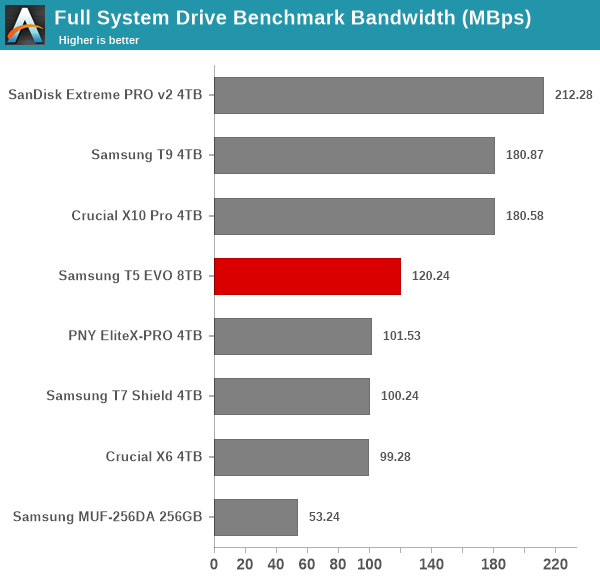
The use of a DRAM-enabled SATA SSD platform allows the Samsung T5 EVO to place itself in the middle of the pack, ahead of even units like the DRAM-less T7 Shield. A faster host interface allows the X10 Pro to outperform the T5 EVO, and the two high-performance SSDs behind USB 3.2 Gen 2x2 bridge chips make up the top two spots.
Miscellaneous Aspects and Concluding Remarks
The performance of the Samsung T5 EVO in various real-world access traces as well as synthetic workloads was brought out in the preceding sections. We also looked at the performance consistency for these cases. Power users may also be interested in performance consistency under worst-case conditions, as well as drive power consumption. The latter is also important when used with battery powered devices such as notebooks and smartphones. Pricing is also an important aspect. We analyze each of these in detail below.
Worst-Case Performance Consistency
Flash-based storage devices tend to slow down in unpredictable ways when subject to a large number of small-sized random writes. Many benchmarks use that scheme to pre-condition devices prior to the actual testing in order to get a worst-case representative number. Fortunately, such workloads are uncommon for direct-attached storage devices, where workloads are largely sequential in nature. Use of SLC caching as well as firmware caps to prevent overheating may cause drop in write speeds when a flash-based DAS device is subject to sustained sequential writes.
Our Sequential Writes Performance Consistency Test configures the device as a raw physical disk (after deleting configured volumes). A fio workload is set up to write sequential data to the raw drive with a block size of 128K and iodepth of 32 to cover 90% of the drive capacity. The internal temperature is recorded at either end of the workload, while the instantaneous write data rate and cumulative total write data amount are recorded at 1-second intervals.
| CrystalDiskMark Workloads - Power Consumption | |
| TOP: | BOTTOM: |
 |
|
 |
|
The T5 EVO has a peak consumption of 4.61 W. The spike in power numbers between the 700s - 835s timestamps point to rapid folding in progress, allowing the SLC cache to be regained.
Final Words
The flash market is currently experiencing a supply glut, with pricing to the advantage of the consumers. This is reflected even in SSDs such as the 870 QVO. The 8TB version of the 870 QVO is available for purchase at less than $350. The inclusion of a bridge chip and the design of a smaller enclosure with additional thermal protection can be expected to add around $50 - $75 to that price. Charitably keeping this number at $100, we would have expected the 8TB T5 EVO to retail around $450. However, Samsung is currently selling the PSSD for $650. This is absurd pricing for a QLC PSSD with speeds limited to 5 Gbps, even if we grant that no other PSSD is currently being sold in the market at that capacity point.
The 2TB and 4TB variants are being sold at $190 and $350 respectively. The 2TB number is palatable, but things start becoming awry with the 4TB version. At that capacity point, PSSDs delivering much better performance with TLC flash and faster host interfaces are available for a much cheaper price. It is not clear whether the T5 EVO presents anything unique at the 2TB and 4TB capacity points to deserve that premium.
While the value proposition is clearly not in favor of the T5 EVO at the current price points, the product definitely deserves credit for creating a new category. QLC is notorious for its slow direct write speeds, an aspect that is easy to encounter in direct-attached storage workloads. By limiting the interface to 5 Gbps (USB 3.2 Gen 1) speeds, the SSD controller is able to fold written data to the QLC segment and free up the SLC cache for the incoming data simultaneously. This allows the end user / application to enjoy the benefits of a much larger SLC cache than what is actually available.
Most PSSDs in the market employ a DRAM-less platform to bring down power consumption and cost. Interestingly, the T5 EVO adopts a board with LPDDR4 RAM for the flash translation layer. This gives the T5 EVO an edge over DRAM-less SSDs (even NVMe ones) for some workloads.
On the technical and product engineering front, the T5 EVO portable SSD is a clear winner, particularly at the 8TB capacity point. The 460 MBps cap may not matter for a wide range of use-cases that is currently being served by portable hard drives. However, the insane pricing throws a spanner in the works. Hopefully, we will see Samsung take the feedback into consideration and market the T5 EVO with a slight premium over the 870 QVO.

